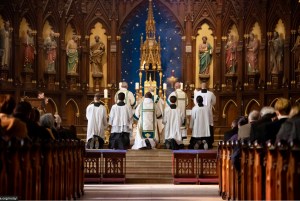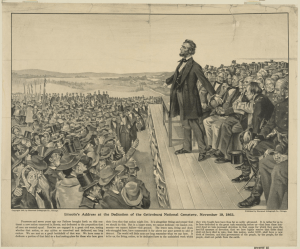We support our Publishers and Content Creators. You can view this story on their website by CLICKING HERE.
Catholics need to be a creative minority, and we need homes for Catholic creatives. The anthem is not so much “fight” as “build, create, empower, love.”
Founded in 2013 by San Francisco Archbishop Salvatore Cordileone, the Benedict XVI Institute works to inspire and enable a renewal of beauty in the liturgy and in the Catholic Arts. Fr. Dwight Longenecker sat down with Executive Director, Maggie Gallagher, to learn more about their work.
Dwight Longenecker: When did you come on board, and how would you summarize the mission of The Benedict XVI Institute?
Maggie Gallagher: Archbishop Cordileone appointed me in 2017. Our mission is to open the door of Beauty to God, and we have two great strategies: providing practical resources for more beautiful and reverent liturgies and energizing a Catholic culture of the arts.
DL: This sounds like a backward, even retrograde mission. Are you simply driven by a quaint conservatism—nostalgic for the art, music, and architecture of the past?
MG: We certainly value the great Catholic art of past generations, but we believe the greatest art, the greatest liturgy the Catholic Church has ever produced is yet to come, and we are pro-active in commissioning new liturgical music, poetry, and writing.
DL: Why Benedict XVI?
MG: Archbishop Cordileone admired Pope Benedict XVI a great deal as a younger priest and valued Pope Benedict’s commitment to reason, kind civility, his personal warmth, and of course his love and brilliant understanding of the Spirit of Liturgy.
DL: It’s exciting to think that beautiful contemporary music is being composed for the liturgy. What are the projects of which you are most proud?
MG: Producing new art in any form is not a once and done process. Whether it is music, film, drama, poetry, prose or art, producing it is one task—getting it out to the audience is another. That’s why our commissioning of liturgical music is not a past project, but an ongoing one.
Our flagship Mass is the Mass of the Americas, a twinned tribute to Our Lady of Guadalupe and Our Lady of the Immaculate conception. It’s really beautiful and moving—it debuted at #1 on the Billboard charts and has generated over 300,000 YouTube hits. And it has entered the canon of the Church in a real way, with celebrations all over America and even in Mexico.
We just celebrated the Mass of the Americas for the first time in Atlanta on July 16. We expect the Mass will be celebrated in major churches honoring Our Lady of Guadalupe in 2025 and beyond.
For a taste listen to this “Ave Maria” in Nahautl —the Aztec language Our Lady spoke to San Juan Diego: It’s ethereal. As the reviewer in Fanfare magazine wrote, “I was floored by the beauty of the music—floored, and then lifted to a different altitude of existence.”
DL: What are some of your current projects?
MG: In addition to the Mass of Americas and Our Lady of Guadalupe project, they fall in several bundles: we have an ongoing project to add new Advent/Christmas carols to the church and the culture. We commission two every year for our annual Very Marian Advent Prayer Service. The latter is a powerful idea: let’s wait with Mary for the coming of Jesus that last difficult month. If you’d like a sample listen to this gorgeous setting of the Chesterton Carol that composer Mark Nowakowski did for us.
Archbishop Cordileone also launched a project to honor the Martyrs of Communism with new hymns, stories, poems, paintings. We commissioned two hymns so far and are looking for patrons for a hymn honoring St. John Paul II and the Martyrs of Polish Communism next.
2026 is the 250th anniversary of the founding of the United States. It’s also the 250th anniversary of the founding of San Francisco by St. Junipero Serra and his Franciscan brothers. We have a number of projects to renew for Catholics the sense of our own history in our own country surrounding that
Composer Frank La Rocca Mass also has planned a Requiem Mass for Pope Benedict XVI, which we would like to be the capstone of conference honoring Pope Benedict’s legacy in 2027, the 100th anniversary of his birth and the 5th anniversary of his death.
This summer we launched our first annual retreat for artists and art lovers. It was very powerful experience and many artists from all over the country flocked to us (including poet Dana Gioia). We’d like to recreate these with mini-retreats or evenings in cities across the country to build more community for Catholic artists and to deepen their understanding of their vocations. Pope Benedict had some interesting things to say about that along with St. John Paul II.
DL: So you haven’t been idle! Are bishops, seminary rectors and seminarians familiar with your work on liturgy?
MG: One of the seminarians at St. Patrick’s Seminary in San Francisco told me he had just come from a national meeting for seminarians. When seminarians from around the country learned he was from San Francisco, he said all they wanted to talk about was the Mass of the Americas. We’ve learned priests are using selections in their First Mass. Of course, Archbishop Cordileone is well known and respected, so yes, I think there is a growing awareness.
DL: What do you think is the most effective strategy in our current culture wars? How does a renewal of liturgy effect a renewal in our wider culture?
MG: Catholics need to be a creative minority, and we need homes for Catholic creatives. The anthem is not so much “fight” as “build, create, empower, love.”
Catholic pastors and seminarians need to be properly educated in the arts. Catholic educators need to invest in the Fine Arts and laypeople who are blessed financially need to see the importance of the arts and be willing to commission new music, art, drama and sacred art. If readers want to learn more about our work they may visit our website here.
Fr. Dwight Longenecker’s book Letters on Liturgy includes a foreword by Archbishop Cordileone. Find it at dwightlongenecker.com.
The Imaginative Conservative applies the principle of appreciation to the discussion of culture and politics—we approach dialogue with magnanimity rather than with mere civility. Will you help us remain a refreshing oasis in the increasingly contentious arena of modern discourse? Please consider donating now.
The featured image is courtesy of the Benedict XVI Institute.
Share This Story, Choose Your Platform!
Go to Top

 Conservative
Conservative  Search
Search Trending
Trending Current News
Current News 





